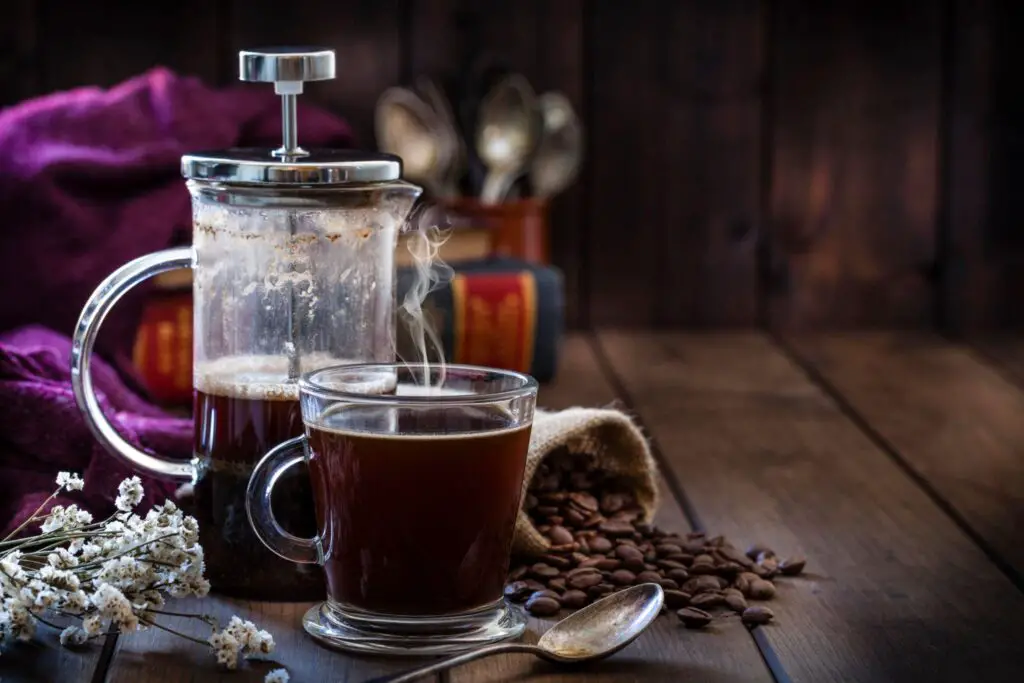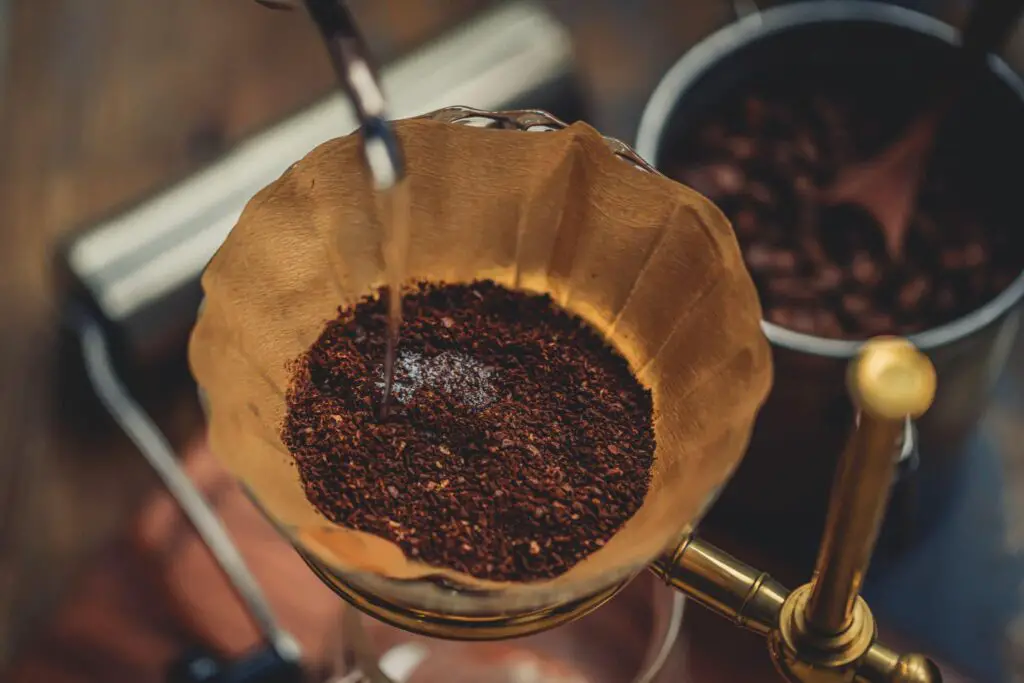Coffee is an essential pick-me-up for most of us, and with so many brewing methods, it can be overwhelming to choose one. French press and pour-over are two popular brewing methods that have gained popularity in recent years. They both offer unique brewing experiences and produce coffee with distinct flavors. While both ways can make delicious coffee, they each come with benefits and limitations. In this blog post, we’ll explore the advantages and drawbacks of French Press vs. Pour Over Coffee to help you decide which method suits your needs best. So grab a cup of Joe and read on!
What Is French Press And Pour Over Coffee?

French press and pour-over coffee are two popular brewing methods coffee lovers use to make the perfect cup of coffee. The French press is designed to produce a more robust cup of coffee as it uses the immersion brewing method. At the same time, the pour-over process uses an infusion method, which creates a smooth and balanced flavor. The pour-over kit has a carafe and a paper filter, whereas the French press has a mesh strainer.
The pour-over is best for hand-brewing one cup of coffee, producing a delicate and less gritty texture. As for caffeine percentage, pour-over coffee has 100-160mg of caffeine, while the French press gives a stronger coffee with a bold flavor due to the water staying in contact. Whether you prefer French press or pour-over coffee, it all comes down to personal preference.
So, next time you’re brewing your morning coffee, try experimenting with these two popular methods to find your perfect cup.
The Basics: French Press Vs. Pour Over Coffee
For coffee enthusiasts, knowing the basics of different brewing methods is essential. The French Press and Pour Over are two popular choices among the many brewing methods. The French Press, a press pot or plunger pot, uses a cylindrical glass or plastic carafe and a plunger/filter with metal or nylon mesh to separate the brewed coffee from the coffee grounds. On the other hand, Pour Over brewing involves slowly pouring hot water over coffee grounds in a filter on top of a carafe or cup.
This method requires more attention to detail but produces a flavorful and nuanced cup of coffee. Both methods involve steeping coffee grounds in hot water, but the extraction process differs. The French Press allows for a full-bodied brew with oils and sediment in the cup, while Pour Over produces a cleaner and crisper taste.
Regardless of which method one chooses, high-quality beans, proper water temperature, and precise measurements are key to making a delicious cup of coffee.
The Benefits Of French Press Coffee
French press coffee is a trendy and popular drink offering various benefits. The French press coffee maker is ideal for those looking for a quick and easy way to get fresh coffee. The coffee maker does not require extra effort and only needs coarsely ground coffee, water, and some time to brew a delicious cup of coffee. The result is a feeling of freshness and a unique flavor that cannot be found in other brewing methods.
Made of heat-resistant borosilicate glass, the transparent glass body of the Big Coffee FY04 French press coffee maker is elegant and modern. It offers world-famous coffee brewing technology functions in a unique style and is made of durable materials for prolonged daily use. Furthermore, the double-wall stainless steel construction of the French press coffee maker keeps your coffee hot and insulates the heat from the outside.
French press coffee is an excellent choice for lovers who enjoy a fresh and flavorful cup of coffee without any extra effort.
The Limitations Of French Press Coffee
Many coffee enthusiasts love French Press coffee for its robust flavor and aroma. However, it does have its limitations. One significant problem is the coffee sludge that must be addressed during brewing. Additionally, French press coffee is made without a paper filter, which can slightly increase cholesterol levels due to the presence of diterpenes.
Furthermore, brewing with a French press requires more time, effort, and attention to detail than other methods. A poorly made or old French press may only remove some grounds, resulting in undrinkable coffee. Lastly, the cleaning process can be messy and time-consuming.
While French press coffee is a beloved brewing method, its limitations should be addressed.
The Benefits Of Pour-Over Coffee

Pour-over coffee has been around for decades, but it’s only in recent years that its popularity has surged. One of the main benefits of pour-over coffee is that it ensures proper extraction of taste and aroma, resulting in a more flavorful and aromatic cup of coffee. Additionally, pour-over coffee makers often eliminate the need for extra filter paper, making it a more eco-friendly option.
Pour-over coffee makers are also portable and easy to carry, making it easy to enjoy freshly brewed coffee on the go. Preparing pour-over coffee is also incredibly simple and enjoyable, allowing coffee lovers to slow down and savor the experience of making their morning cup of Joe.
With many different pour-over coffee makers available in the market, there is an option for everyone to enjoy this delightful way of making coffee.
The Limitations Of Pour-Over Coffee
While the pour-over method offers numerous advantages, such as cost-effectiveness, control over temperature, and the ability to extract flavors, there are also some limitations to this brewing method. It requires more work than using a drip machine, and there is a potential for a disturbance in the coffee layer, resulting in channeling that may hamper the taste. The process can also be time-consuming, and a specific grind size is recommended for optimal results.
However, with practice and precision, pour-over coffee can deliver a rich, nuanced flavor unrivaled by other brewing methods.
Read more:
- How Long Does Espresso Last in The Fridge?
- What is Blonde Roast Coffee and Why Should You Try it?
- Nespresso Vertuo vs. Original: What’s the Difference?
- The Benefits And Limitations Of French Press Vs. Pour Over Coffee
- Traditional Coffee Makers Go Head To Head: Moka Pot Vs. French Press
- Coffee Beans Vs. Espresso Beans: A Guide To Roasting, Grinding, And Brewing
- Keeping It Fresh: How Long Are Coffee Beans Good For?
The Process Of French Press And Pour Over Coffee
Preparing French press and pour-over coffee is a beautiful way to enjoy delicious coffee at home. When using a French press, it is important to first warm it with hot water before adding 20 grams of freshly ground coffee and hot water. Let the coffee steep for a few minutes before pressing the plunger and enjoying the rich flavors and fragrant aroma.
To pour-over coffee, place a filter in the Bodum drip coffee maker and add ground coffee, slowly pouring hot water over the top. The strainer will filter any excess coffee grounds, leaving you with a delicious cup of coffee. Both methods provide a bold and robust flavor that will satisfy any coffee lover’s cravings.
Try using the French press to froth milk for a latte or cappuccino – the results are just as delicious!
Which Is Better For You: French Press And Pour Over?
The French press and the pour-over are two popular options for manual coffee brewing methods. But which is better for you? Well, it depends on your preferences. If you enjoy a strong, robust cup of coffee with dark roasts and bold flavors, then the French press is likely the better option.
On the other hand, if you prefer a smoother, less acidic coffee with lighter roasts and a balanced flavor, then the pour-over is likely the way to go. The French press has a longer brew time and produces a heavier mouthfeel, while the pour-over is quicker to brew and offers more flexibility in adjusting the coffee-to-water ratio.
Ultimately, both brewing methods require more love and attention than automatic coffee makers. Still, they offer a hands-on, personalized coffee experience that can be enjoyed in various settings – from intimate solo morning brews to larger group gatherings.
What Is Easier, Pour Over or French Press?
When it comes to determining which brewing method is easier between pour-over and French press, it often comes down to personal preference and familiarity. Both methods have their own set of steps and techniques, but once you become acquainted with the basics, they can be relatively straightforward to use.
However, many people find the French press to be slightly easier to use, particularly in the morning when you first wake up. The French press involves adding coarsely ground coffee to the press, pouring hot water over it, and allowing it to steep for a few minutes before pressing down the plunger. This method requires minimal involvement and can be done in a matter of minutes.
On the other hand, pour-over coffee requires a bit more finesse. It involves placing a paper filter in a dripper, adding ground coffee to the filter, and pouring hot water over it in a controlled manner. The water must be poured in a circular motion, evenly saturating all the coffee grounds. This process requires more attentiveness and precision to ensure the best extraction.
In terms of speed, the French press tends to be faster than the pour-over. The French press typically takes about four minutes to brew, not including the time spent grinding the beans and boiling the water. Pour-over, on the other hand, may take three to four minutes, depending on the technique and equipment used.
Why Is French Press Better than Drip Coffee?
The French press is often considered better than drip coffee for a few reasons. Firstly, the French press allows for more control over the brewing process, allowing you to adjust factors like grind size, water temperature, and brew time to achieve the perfect cup of coffee. This level of control is ideal for those who are passionate about their coffee and want to experiment with different flavors and profiles.
Secondly, the French press extracts more flavor from the coffee grounds compared to a drip coffee maker. The stainless steel mesh filter in the French press allows the natural oils and fine coffee particles to pass through, resulting in a fuller-bodied and more robust cup of coffee. In contrast, the paper filters used in drip coffee machines tend to remove some of these flavorful oils, leading to a milder taste.
Another advantage of the French press is its simplicity and portability. With no complicated machinery or electrical components, the French press is easy to use and can be taken on the go. This makes it a popular choice for travelers and outdoor enthusiasts who want to enjoy a quality cup of coffee wherever they are.
Lastly, the French press is a more sustainable option compared to drip coffee machines. The use of a reusable stainless steel filter eliminates the need for disposable paper filters, reducing waste and environmental impact.
In conclusion, the French press offers greater control over the brewing process, extracts more flavor from the coffee grounds, is portable and simple to use, and is more environmentally friendly. These factors contribute to its reputation as a superior brewing method compared to drip coffee.
Why Is Pour Over Coffee So Much Better?
Pour-over coffee is considered better for several reasons. First and foremost, it allows coffee enthusiasts to have complete control over their brew’s taste, texture, temperature, and strength. With Pour Over, you can choose everything from the grind size to the water temperature and even the frequency of pours, which can enhance or detract from the final flavor of the coffee.
Pour-over coffee also offers a clarity of flavor that is hard to attain with electric drip coffee makers. The manual pour-over method ensures that all the variables affecting extraction, such as the coffee solubles that dissolve in water, are within your control. This level of precision can extract the coffee’s best flavors while avoiding any off-putting bitter ones.
The Pour-over method also allows for a more articulate and silkier mouthfeel in the brewed coffee. With a little practice, the reward of making a pour-over can be a ritualistic and meditative experience. It becomes a process that brings joy and satisfaction to coffee lovers.
In comparison, drip coffee makers, while convenient, often result in an unbalanced and muddled cup of coffee. While some smart designs and features have improved the quality of drip machines, they still lack the precision and nuance that pour-over offers.
Ultimately, choosing pour-over or drip coffee depends on your preferences and priorities. The electric drip coffee maker may be the better option if you value convenience and a consistent cup of coffee. However, if you enjoy the control, customization, and superior flavor of pour-over coffee, the pour over method is the way to go.
Tips For Brewing The Perfect Cup Of French Press Or Pour Over Coffee
- Invest in a High-Quality French Press or Pour Over Coffee Maker – A good French Press or Pour Over Coffee Maker is essential for crafting the perfect cup of coffee.
- Use Freshly Roasted Coffee Beans – Fresh beans have a richer flavor and aroma than older, stale beans.
- Grind Your Coffee Beans Just Before Brewing – Grinding the beans just before brewing will help preserve the coffee’s flavor and aroma.
- Choose the Right Coffee-to-Water Ratio – A good rule of thumb is to use 1 gram of coffee for every 15 milliliters of water.
- Use water That’s the Ideal Temperature – The water temperature should be just below boiling, around 200-205 degrees Fahrenheit.
- Time Your Steep Properly – The ideal steep time for French Press or Pour Over coffee is between 3 and 4 minutes.
- Use a Clean Filter or Mesh Screen – Clean out your French Press filter or Pour Over mesh screen regularly to ensure your coffee is free from unwanted residue.
- Experiment with Different Roasts and Coffee Blends – Don’t be afraid to try out different varieties of coffee to find the perfect blend for your taste.
- Be Patient – Great French Press or Pour Over coffee takes time, so be willing to wait and enjoy the process.
- Enjoy Your Perfect Cup of Coffee! – Savor every sip and appreciate your effort to make the perfect cup of coffee.
FAQ
Q: What are the benefits of using a French press to brew coffee?
A: Using a French press allows you to brew as much coffee as you like, and it is a versatile method that allows for different types of coffee and drinks, such as lattes and hot chocolate. The French press also uses an innovative preparation method that produces a rich and flavorful cup of coffee.
Q: How do you use a French press to make coffee?
A: To use a French press, start by adding 20 grams of coffee to the press. Next, add hot water and let it steep for a few minutes. Finally, press the coffee down using the plunger and pour the coffee into your cup.
Q: Are there any limitations to using a French press?
A: One limitation is that the French press requires a coarser grind of coffee, which can lead to a less consistent extraction. Additionally, the French press can be more challenging to clean than other coffee brewing methods.
Q: What are the benefits of using a pour-over method to brew coffee?
A: A pour-over method allows for precise control over the coffee brewing process, resulting in a consistently flavorful cup of coffee. Additionally, the pour-over method produces less waste and is easier to clean than other coffee brewing methods.
Q: How do you use a pour-over method to make coffee?
A: To use a pour-over method, place filter paper in the pour-over cone and add coffee grounds. Next, slowly pour hot water over the grounds in a circular motion, allowing the coffee to drip through the filter into your cup. Finally, discard the filter and enjoy your coffee.
Q: Are there any limitations to using a pour-over method?
A: One limitation is that the pour-over method requires more time and attention to detail than other coffee brewing methods. Additionally, it can be challenging to achieve consistent results if you are unfamiliar with the process.
The Final Verdict: Which Coffee Brewing Method Is For You?
So there you have it: the pros and cons of French Press and Pour Over coffee methods. Whether you’re a coffee enthusiast or just someone who enjoys a good cup of Joe, it’s always good to know what you’re getting into. Which method do you prefer? Let us know in the comments below!
References
- https://en.wikipedia.org/wiki/French_press
- https://www.wikihow.com/Use-a-French-Press-or-Cafetiere
- https://www.ncbi.nlm.nih.gov/pmc/articles/PMC7074357/

James Robinson loves coffee and blogging all about coffee. His blog is full of informative posts about the best ways to enjoy coffee and the many different types of coffee out there. He also shares recipes for delicious coffee-based dishes, and his followers can always count on him to offer tips on how to improve their coffee-making skills.
